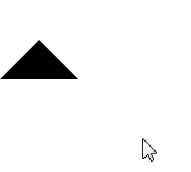虎扯:纯css3各方向小三角的制作原理分析 - 小老虎的牙
入驻博客园两个月之后的第一篇随笔,希望能够做到三个原则:
One:不浪费自己的时间,
Tow:不浪费读者的时间,
第三就是希望有缘的朋友们多多指教,共度前端快乐的大坑!!!
咱们今天来做一个居家旅行必备的小tips,展现前端老前辈的智慧,积淀的文化...
先来一个小口诀【呆会会用到的,不用着急记住它哦】
四方小三角(上,下,左,右)
尖角反方线,给颜色 /*设置边线*/
两边夹角线成透明 /*设置边线*/
参数都相同 /*线的参数都一样*/
给予三条边 /*有三条边哦*/
八方小三角(左上,左下,右上,右下)
左右相反成透明 /*设置边线*/
上下相同给颜色 /*设置边线*/
送你两条边 /*好方便,就两条边*/
哥们上代码:举个梨子
四方来角之(up,up,up上)来个div盒子,是否可以用其他的容器?(哥们没试过,够用就好)
<div class="up"></div>
.up{
position: absolute;; /*这里咱可以视情况而定*/
border-left:30px solid transparent; /*口诀,左,右边成透明*/
border-right:30px solid transparent; /*30px可以控制三角的大小*/
border-bottom:30px solid black; /*口诀,相反线,给颜色*/
width: 0;
height: 0; /*否则小三角在block状态下,会拉满宽度*/
}
结果是:这样的(无视小鼠标)

哥们上代码(2)
先复习一遍口诀,向上向上走...
然后再来,举个梨子(八方来角之“left-top,left-top,left-top左上”)
<div class="left-top"><div/>
.left-top{
position: relative;
border-top: 30px solid lawngreen; /*发现没有上下相同,设置颜色*/<br /> border-right: 30px solid transparent; /*左右相反,给透明*/
width: 0; /*只有两条边的设置哦*/
height: 0;
}
效果图:(完美哦!!)

其中的口诀,可以完全使用,最主要的好处就是可以不用记住源码,自己手写的css然后在网页中完美显示的感觉就是“这个feel倍爽,倍爽...”
主要的用途:
“导航栏中的小三角指向”
“其他暂时没有发现,哈哈哒..”
如果小白同志看见这篇文章的时候,就联系我吧,菜鸟见小白,哥俩泪汪汪
有幸被大神看见,那是三生有幸,希望指导一二
到这为止,小三角tips的博文就玩了,其中原理可理解也可不理解,网上有一大堆的源码,直接拿过来用就是了,但是不符合咱可贵的极客精神
来一起念一遍“极客精神,极客精神..”
片尾声明:
本文的原理是博主自己的收集理解,经过测试完全没有问题,当然也不排除有其他的方式达到这种效果,各位前端的博友有志同道合的请关注我或者我
要关注你哦
最后的落款:
16-03-10日,
环境还是不错的,
周围室友愉快的斗地主

Hot AI Tools

Undresser.AI Undress
AI-powered app for creating realistic nude photos

AI Clothes Remover
Online AI tool for removing clothes from photos.

Undress AI Tool
Undress images for free

Clothoff.io
AI clothes remover

Video Face Swap
Swap faces in any video effortlessly with our completely free AI face swap tool!

Hot Article

Hot Tools

Notepad++7.3.1
Easy-to-use and free code editor

SublimeText3 Chinese version
Chinese version, very easy to use

Zend Studio 13.0.1
Powerful PHP integrated development environment

Dreamweaver CS6
Visual web development tools

SublimeText3 Mac version
God-level code editing software (SublimeText3)

Hot Topics
 1390
1390
 52
52
 Is HTML easy to learn for beginners?
Apr 07, 2025 am 12:11 AM
Is HTML easy to learn for beginners?
Apr 07, 2025 am 12:11 AM
HTML is suitable for beginners because it is simple and easy to learn and can quickly see results. 1) The learning curve of HTML is smooth and easy to get started. 2) Just master the basic tags to start creating web pages. 3) High flexibility and can be used in combination with CSS and JavaScript. 4) Rich learning resources and modern tools support the learning process.
 The Roles of HTML, CSS, and JavaScript: Core Responsibilities
Apr 08, 2025 pm 07:05 PM
The Roles of HTML, CSS, and JavaScript: Core Responsibilities
Apr 08, 2025 pm 07:05 PM
HTML defines the web structure, CSS is responsible for style and layout, and JavaScript gives dynamic interaction. The three perform their duties in web development and jointly build a colorful website.
 What is an example of a starting tag in HTML?
Apr 06, 2025 am 12:04 AM
What is an example of a starting tag in HTML?
Apr 06, 2025 am 12:04 AM
AnexampleofastartingtaginHTMLis,whichbeginsaparagraph.StartingtagsareessentialinHTMLastheyinitiateelements,definetheirtypes,andarecrucialforstructuringwebpagesandconstructingtheDOM.
 Understanding HTML, CSS, and JavaScript: A Beginner's Guide
Apr 12, 2025 am 12:02 AM
Understanding HTML, CSS, and JavaScript: A Beginner's Guide
Apr 12, 2025 am 12:02 AM
WebdevelopmentreliesonHTML,CSS,andJavaScript:1)HTMLstructurescontent,2)CSSstylesit,and3)JavaScriptaddsinteractivity,formingthebasisofmodernwebexperiences.
 Gitee Pages static website deployment failed: How to troubleshoot and resolve single file 404 errors?
Apr 04, 2025 pm 11:54 PM
Gitee Pages static website deployment failed: How to troubleshoot and resolve single file 404 errors?
Apr 04, 2025 pm 11:54 PM
GiteePages static website deployment failed: 404 error troubleshooting and resolution when using Gitee...
 How to implement adaptive layout of Y-axis position in web annotation?
Apr 04, 2025 pm 11:30 PM
How to implement adaptive layout of Y-axis position in web annotation?
Apr 04, 2025 pm 11:30 PM
The Y-axis position adaptive algorithm for web annotation function This article will explore how to implement annotation functions similar to Word documents, especially how to deal with the interval between annotations...
 How to use CSS3 and JavaScript to achieve the effect of scattering and enlarging the surrounding pictures after clicking?
Apr 05, 2025 am 06:15 AM
How to use CSS3 and JavaScript to achieve the effect of scattering and enlarging the surrounding pictures after clicking?
Apr 05, 2025 am 06:15 AM
To achieve the effect of scattering and enlarging the surrounding images after clicking on the image, many web designs need to achieve an interactive effect: click on a certain image to make the surrounding...
 Why do you need to call Vue.use(VueRouter) in the index.js file under the router folder?
Apr 05, 2025 pm 01:03 PM
Why do you need to call Vue.use(VueRouter) in the index.js file under the router folder?
Apr 05, 2025 pm 01:03 PM
The necessity of registering VueRouter in the index.js file under the router folder When developing Vue applications, you often encounter problems with routing configuration. Special...




